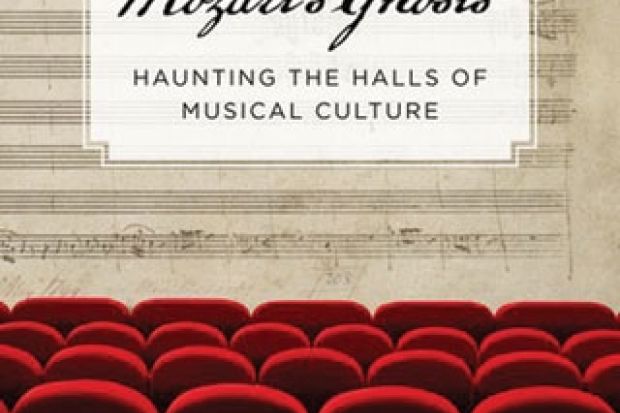At the heart of this book lies the not unreasonable claim that our “modern reverence” for Mozart’s music is founded on its earlier reception, that reception being a more complicated matter than an artist composing and the audience or critic straightforwardly receiving. As Mark Everist notes, it is far easier to track stagings of Mozart’s operas at major European houses than performances of even his large-scale instrumental music, especially before the mid 20th century. Publishing records, however, including arrangements, are more amenable to study, likewise literary and other dramatic treatments.
The footnotes and bibliography render abundantly clear the thoroughness of Everist’s research. His field may verge on the infinite, and coverage cannot yet be selective, but the cases presented are tellingly indicative of more than themselves. We look at the treatment of Mozart in Gaston Leroux’s novel Le Fantôme de l’Opéra and in silent film treatments thereof. Gounod’s Faust remains the central “opera” of the Opéra, yet Mozart’s phantom persists, not least in the guise of references to his Requiem, celebrated as an unfinished, final work – always a draw to a Romantically, indeed sensationally, inclined audience. We consider Offenbach’s fascinating adaptation of Mozart’s Der Schauspieldirektor as L’Impresario to legitimise his theatre as a place of serious musical endeavour.
Nineteenth-century keyboard arrangements of Don Giovanni – severely criticised at the time and thereafter – made both by familiar figures and composers none of us is likely ever to have heard of, transform Mozart into a purveyor, or at least a facilitator, of popular dance tunes. (He wrote a considerable amount of “real” dance music for Vienna, an exquisite Cinderella of his output that, since the death in 1991 of Austrian violinist and conductor Willi Boskovsky, awaits the return of Prince Charming. That, however, is another story.)
Nineteenth-century keyboard arrangements of Don Giovanni transform Mozart into a purveyor of popular dance tunes
Everist is, in proper postmodernist style, scrupulous not to judge; I could not help wishing for some aesthetic judgement to be brought to pass on the striking observation that, in this genre of dance music, “almost any melody of Mozart could be reworked in almost any meter, style, or dance genre”. At what point does Mozart himself fall silent, or at least find himself more or less drowned out, or am I merely succumbing to antediluvian prejudices concerning the “musical work”?
Perhaps the strangest case is that of “Mozart’s Twelfth Mass”, published by Vincent Novello in 1819 almost three decades after the composer’s death, and very shortly after considered spurious in German-speaking lands, always the core of Mozart reception. The anglophone world, however, treated this work very differently. Not only did performance persist; the piece, says Everist, “took on a significance for Mozart reception out of all proportion to the position it ought [a rare judgement, almost malgré lui] to have held”.
Republication continued, for instance by Novello in 1850, in a set of “Three Favourite Masses”, alongside undoubtedly authentic works by Haydn and Beethoven. “The triumphant strains of the Twelfth Mass rolled forth” (neither my words, nor Everist’s, but the author’s) in Jack London’s 1910 novel, Burning Daylight. It even, in a reference intended to designate middlebrow musical taste, has an epiphany in James Joyce’s Ulysses: “the Gloria in that [mass] being to his [Bloom’s] mind the acme of first-class music as such, literally knocking everything into a cocked hat”. That is perhaps not so difficult when the competition comprises confused recollections of Giacomo Meyerbeer and Saverio Mercadante, yet that is part of the point; Joyce’s ambiguity almost has one believe he knew the game was up, although, barring the emergence of new evidence, it seems unlikely.
In addition to offering a partial history of a swindle and some explanations as to why so many were taken in by a work that was probably composed by one Wenzel Müller years after Mozart’s death, Everist informs us that the mass – much, I admit, to my surprise – continues to be performed. Perhaps most bizarre in a truly bizarre tale is the use of its “Gloria” to celebrate the opening of a new airport terminal in Guernsey in 2004, although the continued provision of parts for hire by Novello & Co, with nary a word concerning the provenance of the piece, should elicit eyebrow-raising en masse.
There is much, much more in this fascinating tale of musical spectres. That Everist’s aversion to Mozartian hagiography – “the Mozart effect” – is very much of our time offers no reason to cavil; instead it provokes us to ask questions that he should and, I suspect, would applaud.
